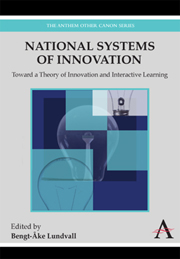Book contents
- Frontmatter
- Contents
- List of Tables
- List of Figures
- Preface
- 1 Introduction
- Part I Toward a New Approach to National Systems of Innovation
- Part II A Closer Look at National Systems of Innovation
- 5 Work Organisation and the Innovation Design Dilemma
- 6 Innovation and the Development of Industrial Networks
- 7 The Public Sector as a Pacer in National Systems of Innovation
- 8 The Role of Finance in National Systems of Innovation
- 9 Formal Scientific and Technical Institutions in the National System of Innovation
- Part III Opening National Systems of Innovation: Specialisation, Multinational Corporations and Integration
- Notes
- References
9 - Formal Scientific and Technical Institutions in the National System of Innovation
from Part II - A Closer Look at National Systems of Innovation
Published online by Cambridge University Press: 05 March 2012
- Frontmatter
- Contents
- List of Tables
- List of Figures
- Preface
- 1 Introduction
- Part I Toward a New Approach to National Systems of Innovation
- Part II A Closer Look at National Systems of Innovation
- 5 Work Organisation and the Innovation Design Dilemma
- 6 Innovation and the Development of Industrial Networks
- 7 The Public Sector as a Pacer in National Systems of Innovation
- 8 The Role of Finance in National Systems of Innovation
- 9 Formal Scientific and Technical Institutions in the National System of Innovation
- Part III Opening National Systems of Innovation: Specialisation, Multinational Corporations and Integration
- Notes
- References
Summary
Introduction
As we have seen in earlier chapters, the concept ‘National System of Innovation’ may be used in two senses: in a broad sense it encompasses all institutions which affect the introduction and diffusion of new products, processes and systems in a national economy; and in a narrow sense it encompasses that set of institutions which are more directly concerned with scientific and technical activities. This book is mainly concerned with national systems in the broad sense and has stressed the importance of the interactions between the production system, the users and innovation. In this chapter, however, we focus more on the narrower set of formal institutions and attempt to outline some major stages in the evolution of these institutions.
Chapter 1 has pointed out that flexibility in the economy does not only derive from market institutions. This chapter shows that the capacity to adapt to major changes in technology has depended historically on the development of a network of scientific and technical institutions, both in the public and private sectors. Whereas chapter 7 has focused mainly on the role of the public sector as user of innovation, this chapter concentrates more on its role as producer.
In the early days of the industrial revolution contact between science and industry was certainly already important (Musson and Robinson, 1969) but it was largely on an individual basis and not on a systematic, continuous basis. Firms were very small and science was largely the province of individual enthusiasts, loosely linked in scientific societies and in national academies.
- Type
- Chapter
- Information
- National Systems of InnovationToward a Theory of Innovation and Interactive Learning, pp. 173 - 192Publisher: Anthem PressPrint publication year: 2010
- 7
- Cited by



